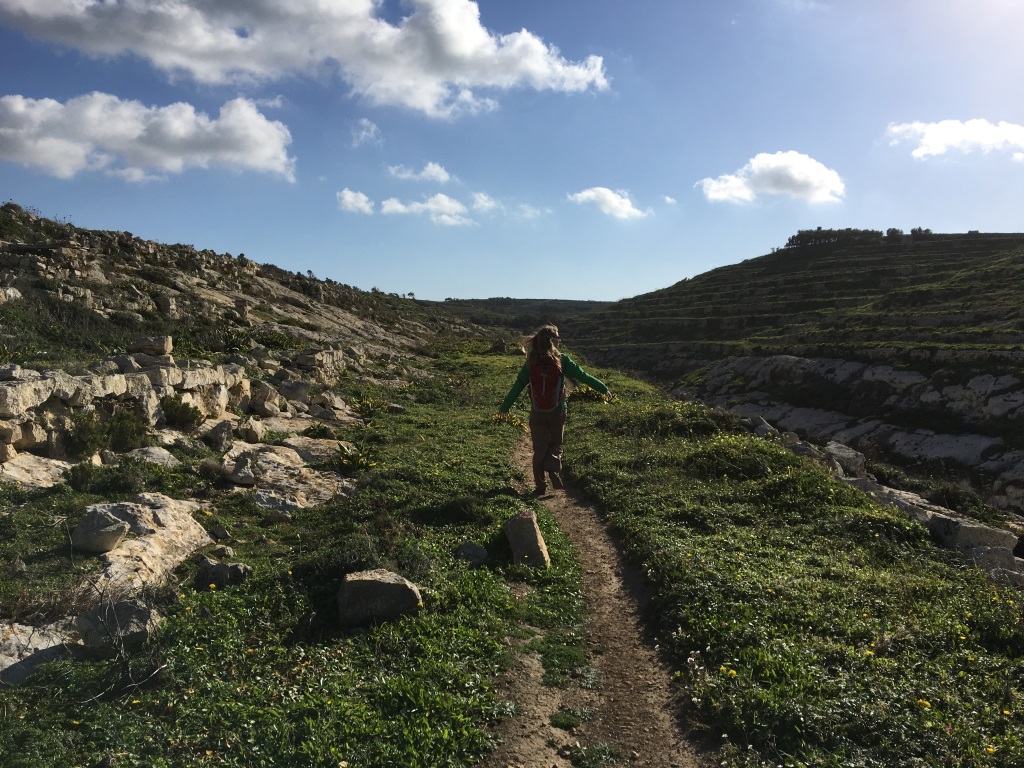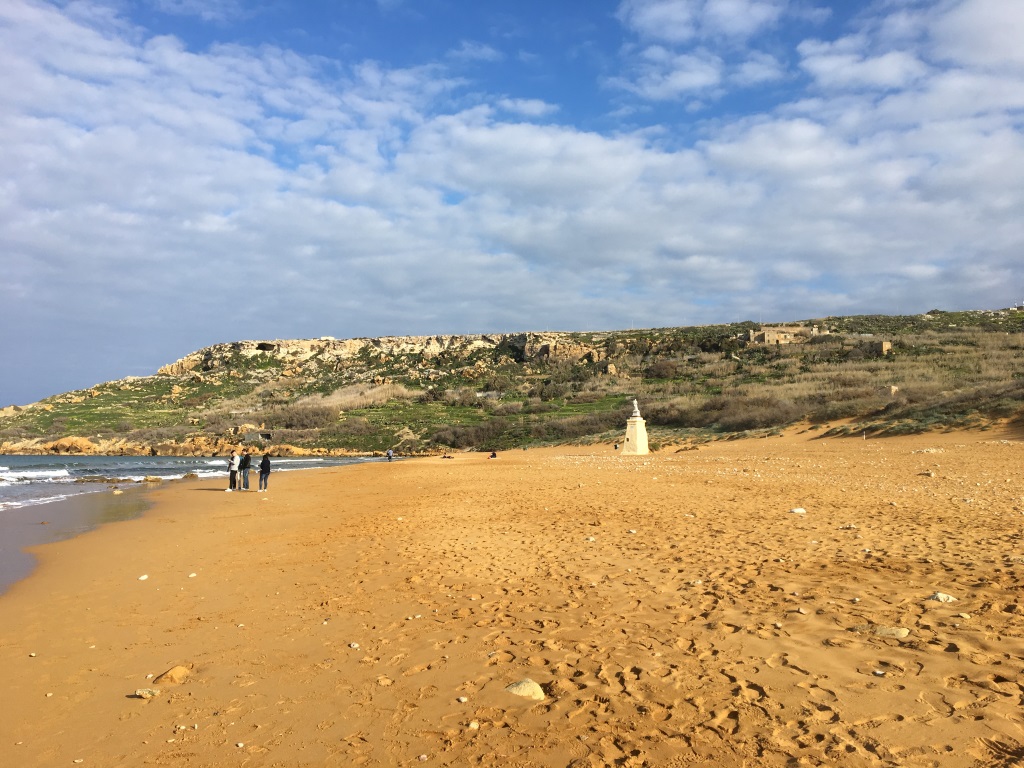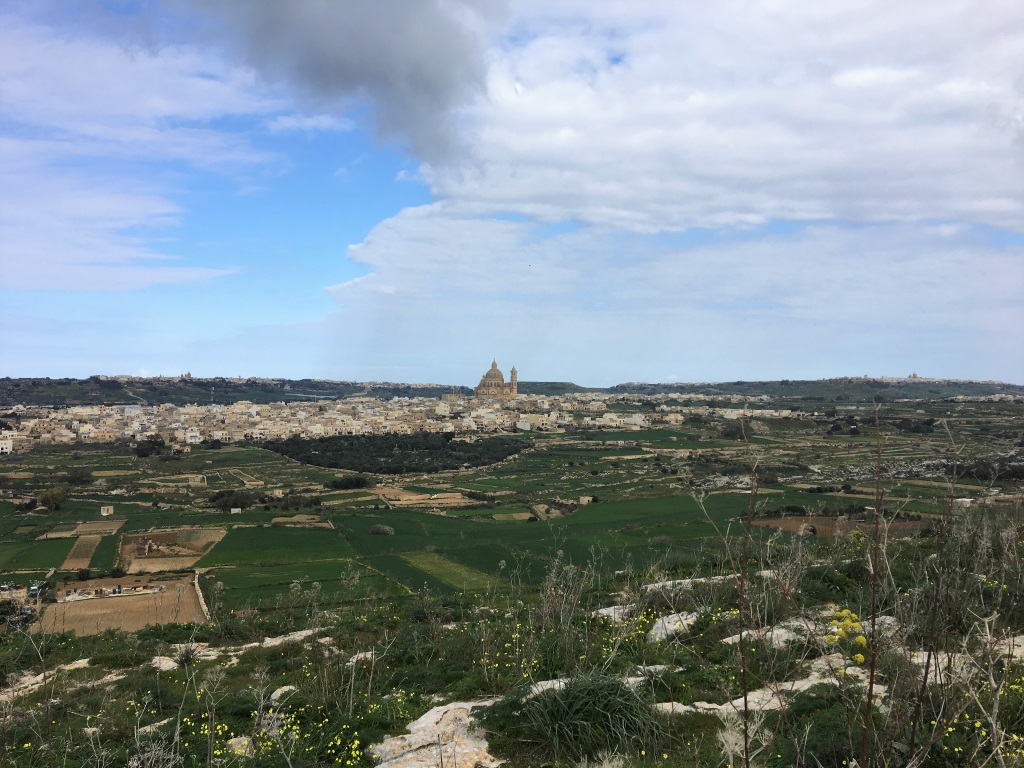
January 2 – 30, 2018 (Winter)
Greeting: Hello
Gratitude: Thank you
Currency: Euro (€)
Visa: Schengen
Cost of living: High
Just a drop in the Mediterranean, Gozo hides in plain sight. It is just 14 km across at its widest and far more rural than Malta – fewer people, fewer buildings, fewer worries. We visited in midwinter, when the temperatures were comfortably cool and the landscape was green and full of wildflowers. Perfect conditions for hiking. And we did hike, as often as possible; criss-crossing the island’s interior, hugging the coast, and exploring what it means to live on a tiny rock adrift at sea.
Where we stayed

Our Airbnb was in a privileged spot at the very head of Marsalforn Bay✨. A wall of windows✨ gave us a stunning panoramic view of the Mediterranean Sea✨, just steps from our front door. Our village of Marsalforn is derisively known as the “touristy” and “overbuilt” part of Gozo, though when we looked around✨ in the low season, those complaints seemed downright comical. Nearly every condo and hotel room in town lay dormant in winter. The only activity came from the construction✨ and renovation crews busily preparing for the next season’s influx. Only a couple of shops and cafés bothered to open, and even then only sporadically.

The weather was rough✨ the day we arrived. Our ferry diverted around Comino✨ to shield itself from biggest swells►. In Marsalforn the waves crashed into the seawall and splashed ten meters into the air – as high as our fourth-floor windows – flooding✨ the waterfront promenade. Later in the evening the wind increased and some waves landed hard enough to shake our entire building. It was a sensation we would be feeling a lot of over the month. Despite the blustery weather, temperatures stayed quite reasonable for January, hovering between during the day. But the stone✨ buildings were better at holding on to humidity than heat. We had to bundle up indoors during the day and turn on the heat after hours. The catch was that it was hooked up to a pay meter✨. The rest of our electricity was included in our rent, but we had to drop about €1.50 per day into the box for a couple hours’ protection against the night chill.

The apartment had a roomy and luxurious layout. Our kitchen✨ had plenty of counters and cabinets, though the oven dials were missing temperature markings, so cooking was guesswork until we looked up the manual online. It was open to the dining area and living room✨. A balcony looked out over the water✨, perfect for sipping wines✨ late on nicer afternoons. We had two bathrooms, one master✨ and one en suite, though the latter was so small that we could barely shut the door behind us. We also had two bedrooms, but stuck to the bigger✨ of the two and kept the other shut off to avoid wasting our precious heat on it.
On both Malta and Gozo the tap water leaves much to be desired. All the liquid coming through the pipes is purified seawater. Though safe to drink, it tastes like chlorine and metal. We used it for cooking and brushing our teeth, but purchased bottled water (less than €3 for 15 liters) for drinking.
Gozo impressed us by having a robust recycling program and even composting✨. It was the most environmentally-conscious place we’ve been since we left Seattle. There were shared bins scattered around town (the best way to dispose of glass, since it was only collected once a month) and a schedule of various collections operating six days a week. The best sign of a quality waste disposal system is when it requires a charts, calendars, and a couple of oracles to sort through what goes out when!
What we did

Gozo is a relaxed place without much✨ going on besides water-based recreation. Since it was too cold to swim and we’re too poor for scuba, we mostly contented ourselves with enjoying the tranquility✨ of the place. There are a few sights of note though, the most important being Ġgantija, the oldest megalithic temple✨ in Malta and among the oldest buildings on Earth. It was already ancient when the pyramids at Giza were constructed. Built of multi-ton stones – megaliths – legends claim it took a giantess to move the rocks into place✨. Any trace of a roof vanished long ago, and the remaining walls✨ honestly don’t look like much. But it was nevertheless interesting to follow in the footsteps of countess (less-conservation✨-minded) travelers on their own Grand Tours and walk among✨ structures that practically predate civilization itself.
Mostly though, we hiked. Our favorites trips were full-day affairs along broad swaths of coastline:
From Marsalforn to DwejraThis hike had everything: salt pans, a sea arch (the largest left after the Azure Window collapsed), trails sided by 300 ft drops to the ocean, and stunning views.
From Marsalforn to RamlaWe waited for the eastbound trail out of Marsalforn to dry out from the rain, then took a leisurely but scenic walk to a small red-sand beach.
From Xlendi to MgarrThe incredible Sanap and Ta’ Ċenċ Cliffs are every bit as beautiful and impressive as Moher, but with none of the crowds. Unless you count sheep!
Each of these hikes was breathtaking and memorable, but they were far from our only ones. Nearly every day we walked; past the salt pans✨, along crumbling roads✨, on top of caves✨, and up a hill with a towering “Christ the Redeemer✨“-like statue. We walked to Victoria✨ multiple times (known to locals as Rabat, but renamed by the British, of course, during their occupation), taking our time to ramble through the smaller streets in the old center. Above the entire city, the Cittadella✨ can’t be missed. We wandered the walls✨, which were free to access. The sweeping views✨ of the island alone were worth the price of admission.
Food & Drink

Although restaurants were rarely open, the three (!) grocery stores in Marsalforn maintained regular hours and clustered just a couple blocks away from our apartment. Lighthouse Supermarket, Galea, and Ta’ Dirjanu had just about everything we needed. That didn’t stop us from venturing further to Lidl, Arkadia, and the Duke in Victoria or Daily Fresh in Xewkija. For a wider variety of meat Cini Tal Mija✨, also in Xewkija, had us covered. Fresh local rabbit and smoked duck breast✨ made up for the extra walking. We prepared the rabbit✨ according to a Maltese recipe✨, a tomato-based stew✨ that got better✨ the longer it aged in our fridge. Already big fans of duck, throwing ham-like chunks of it into omelets and scrambles✨ pretty much made our mornings. On our last day in town, Lighthouse had fresh lamb steaks, which we seared on the stovetop.
Carbs✨ are central to Maltese cuisine. Given the proximity to Sicily, it was only natural that staples included pizza and pasta. We found a good locally-made frozen pizza✨ with goat cheese and Maltese sausage for the days we couldn’t be bothered to cook. The most popular snack on the island must be pastizzi, a ricotta- or pea-filled pastry made with flaky, filo-like dough. Every bakery offered them and for shockingly low (€0.25 or so) prices. Right next to those are qassatat, cone-shaped pot pies filled with cheese or veggies. For dessert, imqaret✨ fits the bill. These deep-fried date bars are akin to an upscale Fig Newton.
Though Gozo has less than of land, it produces a remarkable number* of quality foodstuffs. Ta’ Mena Estate, midway between Marsalforn and Victoria, was a veritable smörgåsbord of locally-sourced goodies. We stopped by to check out their wines and walked out with an armful✨ of merchandise: fresh goat and sheep cheeses, jams, that famous Gozitan sea salt✨, and konserva, a tomato paste thickened with sugar and sea salt that was delicious on toast or in pasta sauce. And of course, wine! Every one we sampled was perfectly drinkable, but our taste buds especially adored their oaked Marsamena Gozo Riserva✨. At just €8.50 a bottle, it was a steal. We bought a substantial✨ number of those, and a couple of their basic table wines (just €3.50) for our simpler meals.
*Suspiciously-many foodstuffs, according to some. Gozo supposedly sells more than three times as much “Gozo honey” as its bees could possibly produce. Buyer beware.

Farsons is the biggest brewery in Malta, and their Cisk✨ lager (pronounced “chisk”) was ubiquitous. It was actually pretty drinkable, and their Double Red✨ was potent if not pleasant. The rest✨ of the lineup was bland-to-bad. Luckily, Gozo offered an alternative. There is exactly one brewery on the island, the craft beer Lord Chambray✨. It’s small✨ for now, but well-funded✨ and with a healthy lineup already (7 styles when we visited, with 3 more on the way). Their beers✨ are expensive at €3 a 330ml bottle, but as essentially the only premium beer producer around, they have a lock on the “discerning beer-drinker tourist” market.
Malta likewise has its own homegrown soda called Kinnie✨. It pops up everywhere, so we felt we had to give it a try. Bad idea. Ingredients such as “bitter oranges” and wormwood contribute to an unapologetically indefensible flavor. Soda machines advertise that it “Adds Taste.” Which is… technically true? Everything we ate afterward indeed tasted of awful bitter garbage cola. Once try was more than enough.
Getting around
Malta did not have Uber and taxis were way overpriced, but getting around on foot or by bus✨ was easy. Buses ran (mostly) on schedule, and all but the 322 (which handily connects Marsalforn to Mgarr’s ferry terminal) stop at the central bus station✨ in Victoria. During the off-season, a single bus ticket costs €1.50 when purchased from the driver. A 12 ride pass (€15) and weekly and monthly passes were also available. Transfers are easy – tickets are good for two hours and passes automatically keep track of this, even between islands.
The ferry is the only way to get between Malta and Gozo, unless you rent a private boat transfer. Round trip on the Gozo Channel Line costs €4.65 for tourists. Tickets are purchased on the return segment only. On the westbound journey we simply walked on✨ to the boat, no ticket necessary.
Stuff of interest
We arrived with SIMs from Croatia, taking advantage of the roam-like-at-home packages now offered throughout the EU. But our data package eventually ran out so we picked up Maltese SIMs↗ from Go! Our data SIMs with 1gb included were $12 apiece.
Unlike many seaside destinations, seagulls were few and far between. Pigeons and crows were similarly rare. This might be due to a local love of bird hunting. Spent shotgun shells✨ littered the island. Or maybe Gozo’s sizable stray cat✨ population had something to do with it. Either way, we didn’t have to worry much about sky bandits stealing our fries.
Watching cargo ships and tankers✨ steam by from our balcony, we began to wonder if there wasn’t some sort of ship-tracking app that could tell us what they were, like Flightradar24 and FlightAware do for planes. Turns out there is! VesselFinder didn’t have AR functionality, but it did have an impressively thorough database complete with photos of just about every significant ship that passed by. It was a good find that we’ll definitely keep in mind on future coastal visits.
Though just about everyone speaks English, most speak Maltese as their native tongue. It is a Semitic language, distantly related Arabic but the only such language to be written in Latin script. To us, it was pretty impenetrable. We learned to pronounce a handful of place names, but that was it.
We broke down and bought an SNES Classic Mini as a belated Christmas gift to ourselves✨. The unit was overpriced, but shipping was included. The only catch was that we didn’t actually know our address (no street numbers) and gave the wrong one. Luckily, Malta Post is a first-rate organization and called us to work out a proper delivery. Good people, those postal workers.
What we learned
Gozo, at least in the low season, is the stuff of dreams for a pair of introverts.






































